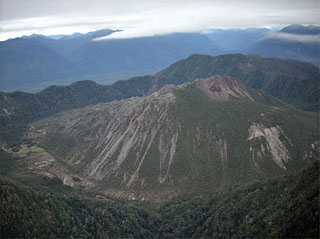Report on Chaiten (Chile) — 7 January-13 January 2009
Smithsonian Institution / US Geological Survey
Weekly Volcanic Activity Report, 7 January-13 January 2009
Managing Editor: Sally Sennert.
Please cite this report as:
Global Volcanism Program, 2009. Report on Chaiten (Chile) (Sennert, S, ed.). Weekly Volcanic Activity Report, 7 January-13 January 2009. Smithsonian Institution and US Geological Survey.
Chaiten
Chile
42.8349°S, 72.6514°W; summit elev. 1122 m
All times are local (unless otherwise noted)
SERNAGEOMIN reported that during 29 December-9 January Chaitén's Domo Nuevo 2 continued to grow and generate a gas-and-ash plume. The plume rose to altitudes of 2.6-3.1 km (8,500-10,200 ft) a.s.l.; block-and-ash flows from frequent spine collapses tinged the plume reddish brown. On 2 January, observers in Chaitén town reported that a block-and-ash flow traveled E and produced a second plume. An overflight on 9 January revealed that Domo Nuevo 1 and Domo Nuevo 2 filled up the 3-km-wide inner caldera. Activity was concentrated on the S part of Domo Nuevo 2. The Alert Level remained Red. According to a news article, Argentine Airlines resumed flights into Esquel airport (about 120 km E) on 12 January, after suspending operations due to ash during the previous eight months.
Based on SIGMET notices and web camera views, the Buenos Aires VAAC reported that on 10 and 12 January ash plumes continuously rose to altitudes 1.8-2.7 km (6,000-9,000 ft) a.s.l. and drifted NNE and E.
Geological Summary. Chaitén is a small caldera (~3 km in diameter) located 10 km NE of the town of Chaitén on the Gulf of Corcovado. Multiple explosive eruptions throughout the Holocene have been identified. A rhyolitic obsidian lava dome occupies much of the caldera floor. Obsidian cobbles from this dome found in the Blanco River are the source of artifacts from archaeological sites along the Pacific coast as far as 400 km from the volcano to the N and S. The caldera is breached on the SW side by a river that drains to the bay of Chaitén. The first recorded eruption, beginning in 2008, produced major rhyolitic explosive activity and building a new dome and tephra cone on the older rhyolite dome.
Sources: Servicio Nacional de Geología y Minería (SERNAGEOMIN), Buenos Aires Volcanic Ash Advisory Center (VAAC), Infobae

